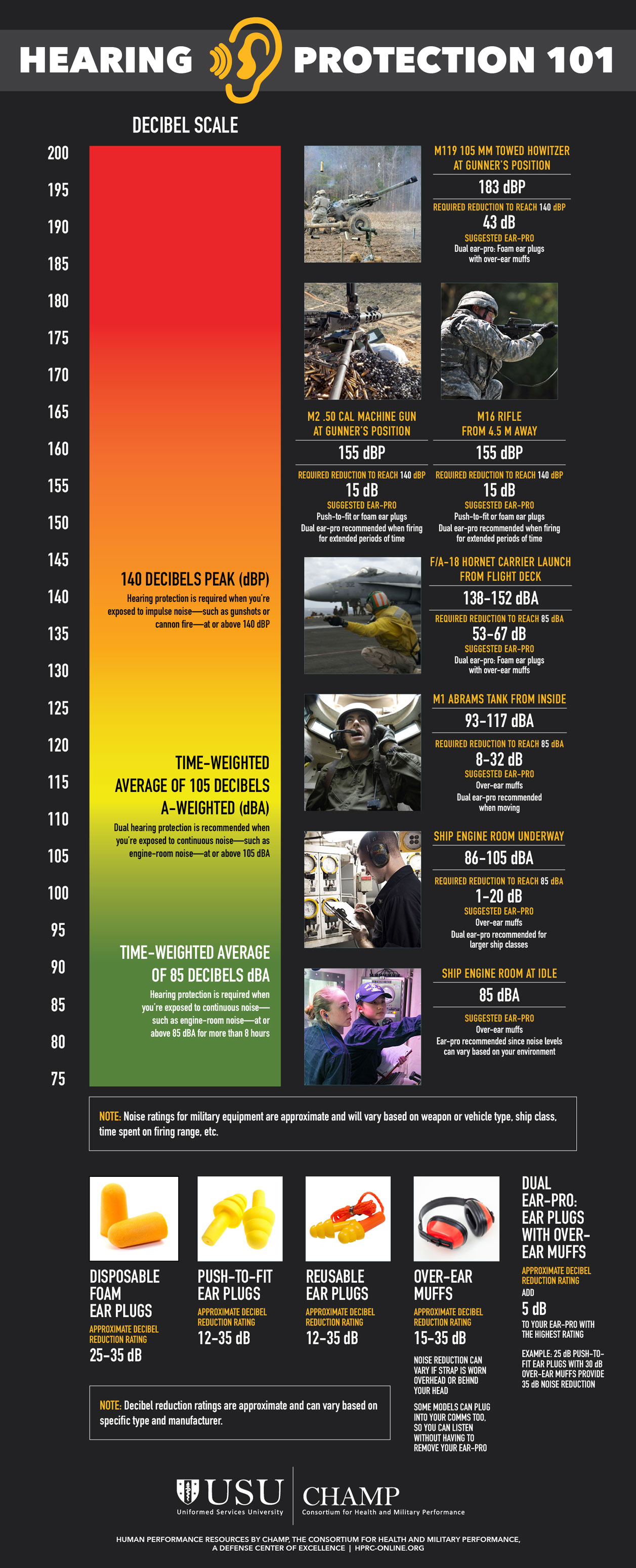Hearing is one of the 5 senses critical to your job performance, situational awareness, and survival on the battlefield. Noises that are too loud or too close can cause permanent hearing damage. Quiet noises that are sustained for long periods of time can increase your risk of hearing damage too. Due to the nature of combat and noisy occupations such as ship-borne engineering, noise-induced hearing loss (NIHL) is among the most common service-related disabilities. Other environmental causes of military-related NIHL include working on the flight deck of an aircraft carrier or in a ship’s engine room.
Your ears are particularly vulnerable to pressure waves generated by explosions and are often the first organ to incur injury during combat. In fact, more than 30% of Service Members exposed to blasts during the Operation Enduring Freedom (OEF)/Operation Iraqi Freedom (OIF) conflicts were diagnosed with ear injuries and tinnitus (ringing in the ears when no actual sounds are present). Other common hearing-related complaints from Service Members include:
- Loudness sensitivity
- Distorted hearing
- Hearing loss
Hearing-related injuries are sometimes referred to as “subtle impairments” because they can be easily overlooked and tend to go undiagnosed until much later in the hearing recovery process. To get ahead of this, DoD now mandates hearing testing both before and after deployment. In addition, each branch has a hearing conservation program (HCP) to help protect the hearing of Service Members. HCPs must be implemented when Warfighters are exposed to:
- Continuous and intermittent noise (20 to 16,000 hertz [Hz]) that has an 8-hour, time-weighted average (TWA) noise level of 85 decibels A-weighted (dBA) or greater.
- Impulse noise (such as gunshots), sound-pressure levels (SPLs) of 140 decibels peak (dBP) or greater.
- Ultrasonic exposures, which occur under special circumstances that require specific measurement and hazard assessment calculations.
To provide context to DoDI 6055.12: Hearing Conservation Program (HCP), the noise level of a ship’s engine room when in port with engines idling is about 85 dBA and can range from 86–105 dBA when underway. For peak impulse noise, an M16 rifle is about 155 dBP from 4.5 m away, an M2 .50 cal. machine gun is about 155 dBP at the gunner’s firing position, and an M119 105 mm Howitzer’s noise level is about 180 dBP when measured from the gunner’s position.
Choosing hearing protection
It’s essential for key noise levels to be below 85 dBA for continuous noise and 140 dBP for impulse noises such as gunshots. At times, you might need dual ear-pro (ear plugs worn under ear muffs) to help reduce noise levels. There are many different types of plugs and muffs that could be provided by your unit, so it’s important to know the noise reduction rating for your specific type when choosing hearing protection.
Some examples of ear-pro and their noise reduction ratings are:
- Disposable foam ear plugs: 25–35 dB
- Push-to-fit ear plugs: 12–35 dB
- Reusable ear plugs: 12–35 dB
- Over-ear muffs: 15–35 dB
Keep in mind there’s some major overlap between noise-reduction rating ranges. The ratings will vary based on type and manufacturer, so it’s important to pay attention to the ratings that your unit provides. Depending on your situation (for example, if you’re a ship engineer underway), you might need to wear dual ear-pro to bring your noise exposure down from 105 dB to a more acceptable level below 85 dB (that is, plugs with 25 dB of protection plus muffs with an additional 5 dB). See HPRC’s “Hearing Protection 101” for examples of what’s available.
Bottom line
While hearing protection is necessary and required, it often can interfere with situational awareness, communication, and job performance. Still, if you’re in an engine room, the first sign that something is wrong is often an abnormal sound. The good news is some recent developments in ear-pro allow your comms to be plugged directly into your ear muffs so you can still communicate without exposure to dangerous noise levels. You also might find it helpful to use this type in your environment when possible.
Effective hearing protection requires wearing your ear-pro properly. Visit the DoD Hearing Center of Excellence to learn more about proper wear. Or submit your question through HPRC’s Ask the Expert feature, and subject-matter experts will research your question and respond within a few days.

Hearing Protection 101
Decibel Scale:
140 decibels peak (dBP): Hearing protection is required when you're exposed to impulse noise - such as gunshots or cannon fire - at or above 140dBP.
Time-weighted average of 105 decibels a-weighted (dBA): Dual hearing protection is recommended when you're exposed to continuous noise - such as engine-room noise - at or above 105 dBA.
Time-weighted average of 85 decibels (dBA): Hearing protection is required when you're exposed to continuous noise - such as engine-room noise - at or above 85 dBA for more than 8 hours.
M119 105 MM Towed Howitzer at Gunner's Position: 183 dBP
Required reduction to reach 140 dBP: 43 dB
Suggested ear-pro: Dual ear-pro - Foam ear plugs with over-ear muffs
M2 .50cal Machine Gun at Gunner's Position: 155 dBP
Required reduction to reach 140 dBP: 15 dB
Suggested ear-pro: Push-to-fit or foam ear plugs; Dual ear-pro recommended when firing for extended periods of time
M16 Rifle from 4.5m away: 155 dBP
Required reduction to reach 140 dBP: 15 dB
Suggested ear-pro: Push-to-fit or foam ear plugs; Dual ear-pro recommended when firing for extended periods of time
F/A-18 Hornet Carrier Launch from Flight Deck: 138-152 dBA
Required reduction to reach 85 dBP: 53-67 dB
Suggested ear-pro: Dual ear-pro - Foam ear plugs with over-ear muffs
M1 Abrams Tank from inside: 93-117 dBA
Required reduction to reach 85 dBP: 8-32 dB
Suggested ear-pro: Over-ear muffs; Dual ear-pro recommended when moving
Ship Engine Room Underway: 86-105 dBA
Required reduction to reach 85 dBP: 1-20 dB
Suggested ear-pro: Over-ear muffs; Ear-pro recommended since noise levels can vary based on your environment
Note: Noise ratings for military equipment are approximate and will vary based on weapon or vehicle type, ship class, time spent on firing range, etc.
Types of ear-pro
- Disposable foam ear plugs: approximate decimal reduction rating: 25-35 dB
- Push-to-fit ear plugs: approximate decimal reduction rating: 12-35 dB
- Reusable ear plugs: approximate decimal reduction rating: 12-35 dB
- Over-ear muffs: approximate decimal reduction rating: 15-35 dB
- Noise reduction can vary if strap is worn overhead or behind your head
- Some models can plug into your comms too, so you can listen without having to remove your ear-pro
- Dual ear-pro - Ear plugs with over-ear muffs: approximate decimal reduction rating: add 5 dB to your ear-pro with the highest rating
- Example: 25 dB push-to-fit ear plugs with 30 dB over-ear muffs provide 35 dB noise reduction
Note: Decibel reduction ratings are approximate and can vary based on specific type and manufacturer.
Uniformed Services University | Consortium for Health and Military Performance
Human Performance Resources by CHAMP, the Consortium for Health and Military Performance, a Defense Center of Excellence | hprc-online.org
Published on: March 30, 2022
References
Dangerous Decibels. (2018). Decibel exposure time guidelines: How loud is too loud? Retrieved from http://dangerousdecibels.org/education/information-center/decibel-exposure-time-guidelines/
Centers for Disease Control and Prevention. (July 22, 2011). Hearing impairment among Military Veterans. Retrieved from https://www.cdc.gov/mmwr/preview/mmwrhtml/mm6028a4.htm
Dougherty, A. L., MacGregor, A. J., Han, P. P., Viirre, E., Heltemes, K. J., & Galarneau, M. R. (2013). Blast-related ear injuries among U.S. military personnel. Journal of Rehabilitation Research and Development, 50(6), 893–904. doi:10.1682/jrrd.2012.02.0024
Munjal, S. K., Panda, N. K., & Pathak, A. (2010). Relationship between severity of traumatic brain injury (TBI) and extent of auditory dysfunction. Brain Injury, 24(3), 525–532. doi:10.3109/02699050903516872
Wells, T. S., Seelig, A. D., Ryan, M. A. K., Jones, J. M., Hooper, T., Jacobson, I. G., & Boyko, E. J. (2015). Hearing loss associated with US military combat deployment. Noise and Health, 17(74). doi:10.4103/1463-1741.149574
